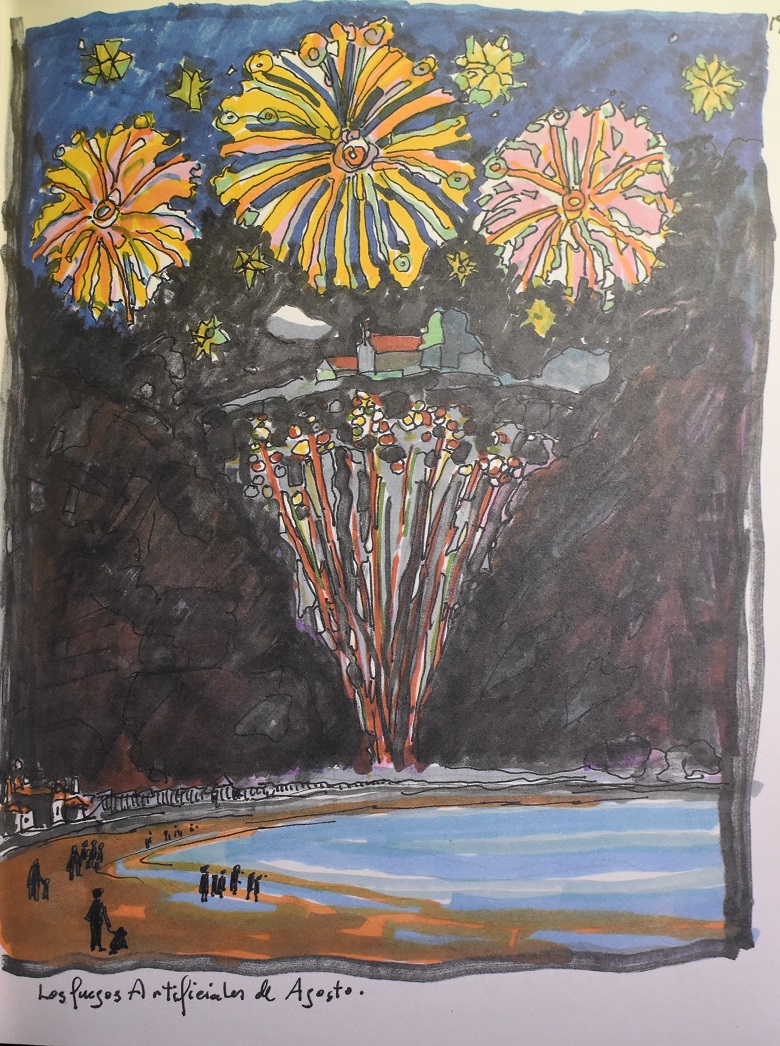
- In the Zarautz Malecon he has spent hours of bush at the San José goal. “The colors are four, they’re enough,” he said, withdrawing to Getaria’s silhouette. The Civil War radically changed her life, but with old age she regained her youth and her youth.

He returned to Zarautz as soon as he retired, to the town where he lived as a child. It felt as if it had gone back years, as the Basque country once again occupied a space in its day to day. He started painting more often, and every day, grabbing space in the Zarautz Malecon, painting with loose, dense brushstrokes, the Getaria he saw every day. The cries of the gulls and the sun rays made the places of one day and another very different for him.
No one knows Mendi as Josu Txapartegi Txapas; we've been with him to talk about Mendi. Txapas was a bridge to approach the children, who in addition to being his friend was a professor at the Ikastola de Zarautz. We have had many curiosities among which is a journal that the painter used to write his thoughts, written between 1992 and 1993.
Juan Luis Mendizabal Mendi was born in 1928 in Lekeitio and moved to Zarautz. During the first ten years of his life he immersed himself in the Basque environment, but in 1938 his family had to leave to Donostia-San Sebastián. “War changed my world,” Mendi says in a passage in his journal. He worked at the CAM – Municipal Savings Fund, now Kutxabank – until his retirement as head of the culture area. When he was 60 years old, he returned to Zarautz and somehow approached his previous life to San Sebastian: since then he would live surrounded by Euskera. On March 19 he was the last to die Mendi, 91 years old, accompanied by his two daughters.
If something pleased Mendi, it was to be able to reuse the Basque child in old age. “In Iñurritza (college) we only spoke Basque and had to learn Spanish, that has been the biggest problem I have had in my life,” says Mendi on a daily basis. Next to him is the current Ikastola de Zarautz, as Txapas reminds him, which opened his heart and the illusion of seeing a thousand children learning only in Basque.

Catholic and anarchist
He was always a believer, although in old age many doubts arose; corruption and paedophile cases taken from the interior of the church were very damaging to him. As for the Catholics, as anarchists, he united them to the right: “The authorities of the Church have managed better with the right of always, at least from the Catholic Kings.” He also cited and often criticized that there were too many people in the Church as a political authority.
He didn't like the bourgeoisie. Much less those who had money and those who lived in the Basque Country but did not care about promoting Basque culture. “They never have any doubts, but sometimes I have fun with their words. They have no interest in the Basque Country, they do not care about their future. For them, the most important thing is money and power,” he says in a passage.
Oteitza accompanied you
Jorge Oteiza, 20 years old, was a sculptor of Orio who accompanied him in his old age. They were neighbors and Mendi was often going to visit her. He could be understood in everyday life and worried about his friend's situation. In a passage it says: “He tells me that nothing interests him, that he has become angry with a fellow sculptor and that he does not want to know anything about the ikastolas, he has become angry with the birds.” Oteiza then had three years of life expectancy.
Although it was contrary to all religious beliefs, when talking about politics it often coincided with Mendi. She once passed a piece of poem on to Mendi, and she kept a few of them and picked them up on a daily basis. In one of them he talked to him about the gravity that the Francoists had become democrats.
On Monday, to learn how to paint with children
The dog next to him and the Euskera in the mouth, on Monday morning, was heading to the Ikastola Salbatore Mitxelena of Zarautz. Almost 100 children aged 6 and 7 were waiting for him, including me. As Txapas says, for Mendi it was a fresh wind. With enthusiasm and enthusiasm, and always in Euskera, we were willing to get our imagination to work. Taking the cart from time to time we started the path to the malecon, and we looked at both the Rainbow and Getaria, to see what we imagined and what we saw later with the paintings. To collect the experience, and of course to thank him, we made a video with the help of Pirritx and Porrotx, and Mendi himself seemed to also appreciate his assistance to the Ikastola. He wrote in his diary, along with the students' photography: “I hear the children singing from the ikastola. They are the last hope of the Basque Country.”
Mendi was an expert in hijacking time, but last week he was kidnapped over time. We are very grateful for having known him, and we are also grateful for the help of Txapas to be able to do this article, especially for showing that the great old man was much more than a painter.